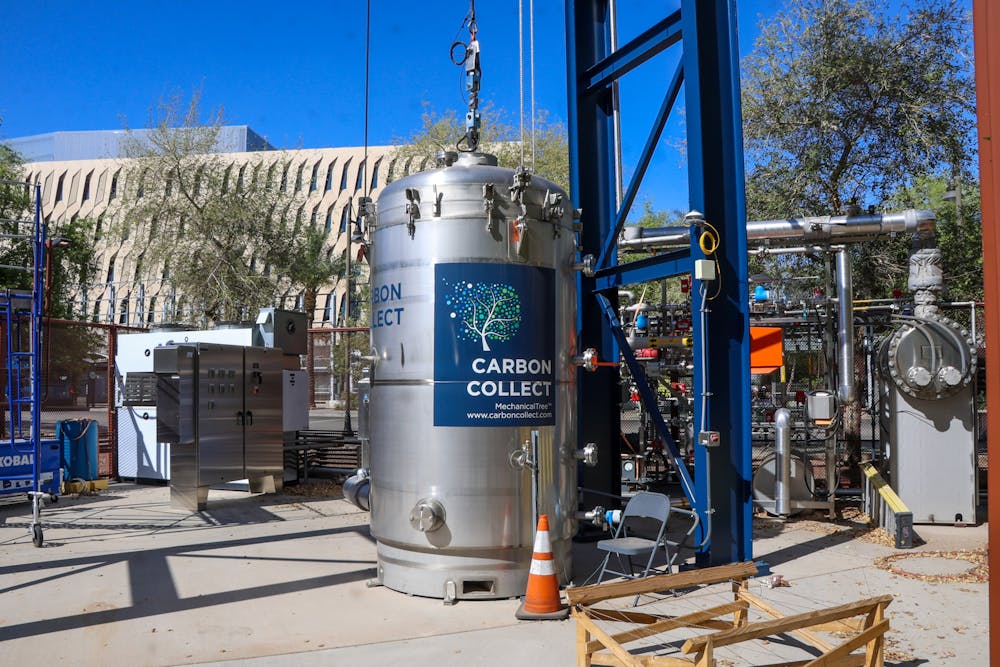Pulling carbon dioxide straight from the air sounds like science fiction, but it is real and can be found rooted at ASU, where the world's first MechanicalTree stands. Scientists, however, are split: Are carbon capture technologies a climate breakthrough or a net negative?
In 2022, ASU planted the metal tree at the Walton Center for Planetary Health, based on research by Klaus Lackner, founding director of the Center for Negative Carbon Emissions. Lackner worked with Irish-based company Carbon Collect.
In January 2025, ASU received an $11.2 million grant to build a carbon capture hub in the Southwest, in partnership with Carbon Collect.
As of April 28, Carbon Collect did not have a business website.
According to Matthew Green, director of the Center for Negative Carbon Emissions, the MechanicalTree uses a passive process to capture carbon dioxide. It relies on the natural movement of the air to bring carbon into contact with the tree's panels and does not rely on fans or blowers.
"The mechanical tree removes carbon dioxide from the air about 1,000 times faster than a natural tree," Green said. "One of those things does the work of 1,000 trees."
While carbon capture technologies are growing and sparking optimism, critics argue that they are a distraction from other climate solutions.
"The public has no idea about anything about carbon capture. They just accept whatever's been told," said Mark Z. Jacobson, professor of civil and environmental engineering at Stanford University and critic of carbon capture technologies.
Jacobson argued that instead of investing in carbon removal, efforts should be made to prioritize preventing emissions.
"We should focus on using renewable energy and replacing fossil and bioenergy sources with renewable energy," Jacobson said. "It would definitely be better if we can place more emphasis on renewable energy and focus on electrification."
The team behind the MechanicalTree believes that carbon removal can supplement the transition to renewables.
"We have demonstrated that you can just capture CO2 from ambient air," said Pól Ó Móráin, CEO and co-founder of Carbon Collect. "The real challenge is, how can you scale? How can you get down the cost curve?"
ASU researchers are working on additional trees to scale the carbon capture technology. Another MechanicalTree is in the works and will soon be installed, Green said.
In the next few months, the MechanicalTree will be undergoing upgrades, Ó Móráin said.
"The front end of that will be swapped out for the second-generation system in a couple of months," Ó Móráin said. "(We’re) demonstrating that we would actually be the first direct air capture company to run a regeneration in a non-metal environment."
Ó Móráin said currently, there are ongoing projects related to carbon capture around the world in places including Europe, South Africa, Japan and Australia.
Even with such developments, skepticism remains about the broader impact of carbon capture. Jacobson said carbon capture creates more problems than it solves.
"Carbon capture only increases carbon dioxide, air pollution, fossil mining, fossil infrastructure, pipelines, energy costs, health costs, climate costs and social costs," Jacobson said. "It's only a negative, there's no benefit whatsoever and there never will be."
Edited by Sophia Ramirez, Sophia Braccio and Natalia Jarrett.
Reach the reporter at mmart533@asu.edu.
Like The State Press on Facebook and follow @statepress on X.
MJ is a freshman studying computer science and journalism and mass communication. This is her first semester with The State Press. She has also worked on her high school newspaper.




